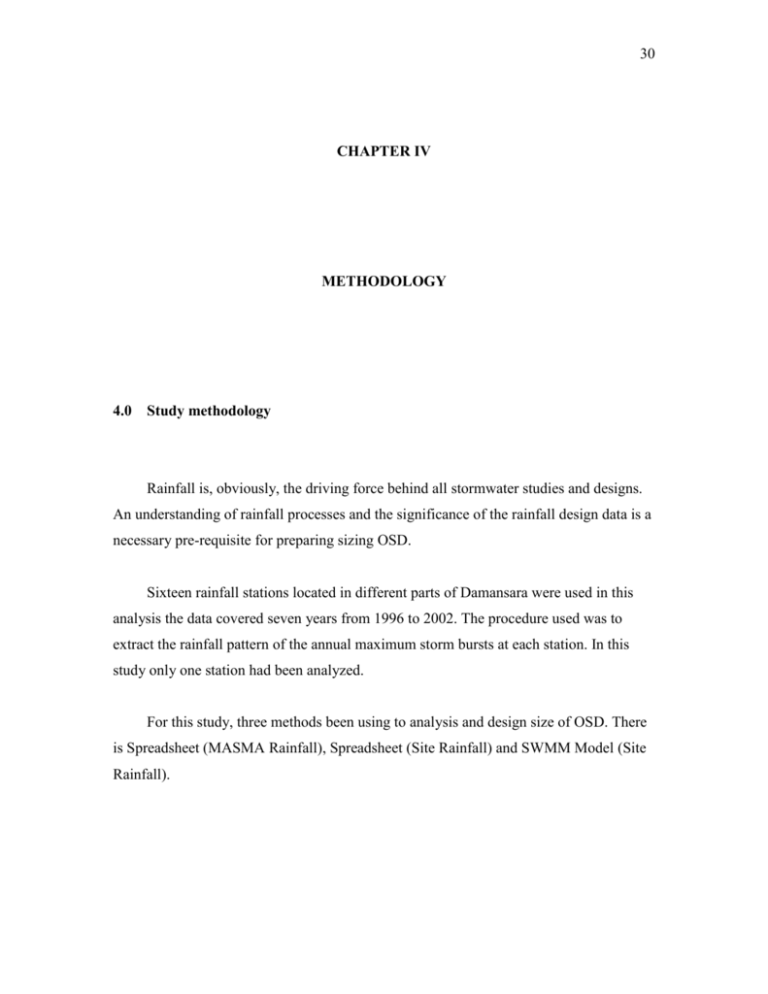CHAPTER IV
advertisement

30 CHAPTER IV METHODOLOGY 4.0 Study methodology Rainfall is, obviously, the driving force behind all stormwater studies and designs. An understanding of rainfall processes and the significance of the rainfall design data is a necessary pre-requisite for preparing sizing OSD. Sixteen rainfall stations located in different parts of Damansara were used in this analysis the data covered seven years from 1996 to 2002. The procedure used was to extract the rainfall pattern of the annual maximum storm bursts at each station. In this study only one station had been analyzed. For this study, three methods been using to analysis and design size of OSD. There is Spreadsheet (MASMA Rainfall), Spreadsheet (Site Rainfall) and SWMM Model (Site Rainfall). 31 4.1 OSD design flowchart Site selection for study area Data collection for 1-minute rainfall from automatic station, JPS Selangor Data source Selection storm duration 5 minutes, 15 min, 30 min, 60 min, 3 hour to 24 hours Develop observed rainfall pattern for the selected storm duration Develop design rainfall temporal pattern Determine of annual rainfall maximum rainfall for the selected duration Identification top 5 for all maximum rainfall Determine of hydrologic and hydraulic cat eristic Landuse and land cover Development of model in rafts or SWMM Conduct modeling for different rainfall duration Sizing OSD from computer model (SWMM) and using MSMA equation chapter19 Comparison of result between of SWMM and MSMA Determine critical part of osd 32 The statement of the following chart for this study the first step is to find out, determine the expected result, the objective and also the scope of work. The data will be collect from the automatic stations JPS Selangor that can get from DID. For the Damansara catchment , there are 16 rainfall stations. The data is for one minute rainfall that is for seven years for one station there is from 1996 to 2002.. For the landuse for this study, the site maps with contour, building and site detail plan and also the size of discharge will be collect. For this study only one station would be analyzed. For analyzed the data there are a few steps to get the result. 1. Annual rainfall pattern Get the maximum rainfall for every month for one year. Do it for seven years from 1996 to 2002. Get the maximum rainfall from seven year. The maximum rainfall should be include for 5 minute, 15 minute, 30 minute, 1 hour, 3 hour, 6 hour, 12 hour and 24 hour. 4.2 With the data ,HYFA modeling will be used to get the tabulated rainfall analysis SWMM-XP Model SWMM-XP was originally developed by the Environmental Protection Agency (EPA), USA and was then modified with additional hydrologic models within the software by WP Software, Australia. Willing & Partners Pty. Ltd. have then carried out significant developments on the model, as well as program enhancements, which have 33 ultimately prompted revision from earlier version of the SWMM model. The purpose of the model is to simulate runoff hydrographs at defined points throughout a watershed for a set of catchment conditions and specific rainfall events. The watershed is subdivided into a number of sub-catchmants from which runoff hydrographs are produced and routed through any conceivable network of storage, channels and pipes to determine flood mitigation and drainage strategy or hydraulic design data for structures. Sub-catchment routing is based on Laurenson’s (1964) runoff-routing method where sub-catchments are divided into sub-areas with boundaries delineated by isochrones. The model then breaks the sub-areas into 10 sub-catchments defined between lines of equal travel time or isochrones. The storage, however, is a non-linear function of the discharge is of the form; S = B . Qn . Q ….. (4.2) Where, S = volume of storage, (hours x cu.m/s) B = storage delay time coefficient n = storage non-linearity exponent Q = the discharge in cu. m/s. To get the Permissible Site Discharge (PSD) and Site Storage Requirement (SSR) by using the SWMM modeling, the temporal pattern should been calculate and analyzed from the data. 34 Temporal pattern By using the data from maximum rainfall from seven years, take the top five maximum rainfall to do analysis. Analysis the data to get the table of analysis rainfall temporal pattern for every duration. The result show at table 12.0 until 19.0. Using the result of percentage maximum rainfall and fraction for every duration to get the graph of rainfall distribution for every storm duration . Analyzed the data to get the graph of average rainfall distribution for every duration , graph actual, normalized graph and graph of design temporal pattern for every duration that show at graph 2.0 until graph 29.0.






